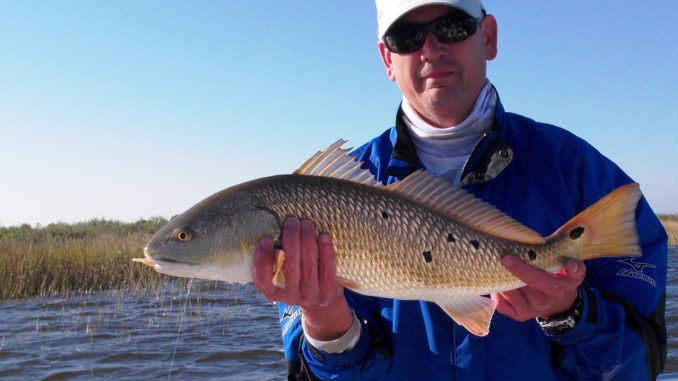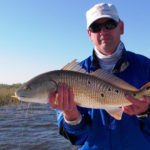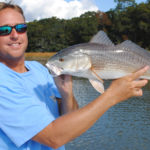
Does weather affect fish? A gracious plenty
November is a great month, actually one of the best, to be fishing along the North Carolina coast. However, many fishermen consider it to be the last of the fall months with great fishing and are ready to hang up their rods about halfway through. If you’re doing that to start hunting, I won’t be too harsh on you, but if you’re stopping midway through November because of some preconceived notion the great fall fishing is ending because the water temperatures are getting too low, you are the person that needs to clean your glasses, take a seat and read this to the end.
The great fall fishing doesn’t end in mid-November; it may not even be slowing towards the end of the month. If we have cool mornings requiring a little more coat than a windbreaker, it could actually help your fishing. The key is understanding that the water is cooling and how that affects the fish and their inclination to feed. Many times, locating water that is just a little warmer can be a major plus.
Fish are sensitive to changes in the weather. I don’t know how they can tell which way the wind is blowing, but they certainly seem to have some preferences. What I’m sure they can tell is changes in the temperature, both in the water and in the air, and changes in the barometric pressure.
I expect some aspiring meteorologist can find a way to correlate these factors to the wind. I have a little theory, but no scientific way to evaluate it, so I won’t expound on it. For this, let’s look at the things we can easily understand and agree affect the fish.
Most biologists will agree that fish bite best on a steady to slightly rising barometer. These are typically the nice days that are sunny, even if they aren’t warm, and the weather isn’t changing.
There is also a spike in feeding activity when the barometer first starts to drop, especially if it is a slow or steady drop. The falling barometer signals a change in the weather, usually rain or some disturbance, and fish will usually feed heavily while the barometer is dropping slowly in preparation for the change. When the barometer starts dropping quickly, it is usually an indicator the bad weather is close or rapidly approaching, and the fish stop feeding and seek shelter from the approaching weather cell. Just for a point of reference, keep in mind that one of the indicators of the strength of a hurricane is how low the barometric pressure drops.
We can’t do much about barometric pressure and temperature, but by thinking ahead and using a little common sense, we can time our fishing to coincide with the right movement of barometric pressure and look for places in the water where there are temperatures more suited to get fish in a feeding mood. For the barometric side of this, I’ll suggest fishing early on as the weather first begins to change from good to bad and then concentrating on the second day on after the front, cold snap or whatever weather issue passes and we can move on to temperature.
With their sensitivity to their habitat, fish can feel and respond to small changes in temperature. I have seen major differences in the quality of a bite that only required half a degree. For our purposes, let’s say they often respond to changes as small as a degree — and several degrees is a big change. The point is, when the water starts really cooling during the fall, finding some water that is only a degree or two warmer can make the difference between just casting all day or having fresh fish for dinner.
We can’t make the water warmer, but we can look for those spots where it is naturally warmer. Consider that sunlight is the most-important factor that warms water during the cooler months, and the more exposure to sunlight, the more potential an area has to be warmer than the water in surrounding areas.
Let’s start with a simple thought. If depths and the composition of the bottom are similar, typically the west bank of a creek or bay will be the warmest from early in the day until late in the afternoon because it receives the first rays of the morning sun. Even if the tree line is low and only blocks the sun for a little while, the east side has some shading in the mornings and won’t begin warming until the sun shines on it.
I’ll continue right into shadows here, because they are a similar detriment to warming. A section of a creek or marsh that has a lot of shade will not warm as quickly, because the sun doesn’t it and can’t shine on it. Late in the day, when the shadows reach the water on the west bank of a creek or bay, it will begin cooling while the east bank remains warm. A degree of temperature difference along a shadow line can sometimes mean feeding fish on the sunny side and fish with lockjaw on the shadow side.
Water over darker bottoms warms more quickly. We know that darker surfaces tend to absorb light and become warmer, while lighter-colored surfaces reflect light and aren’t as warm with the same exposure. This is true with the bottoms of rivers, creeks, bays and ponds, too. The darker bottoms absorb any light that penetrates the water and will be a little warmer than lighter bottom areas. This is magnified by water depth, or maybe more appropriately the lack of water depth. In shallow water, more light penetrates to the bottom which warms the bottom more than it will in deeper water.
The extreme of this is at low tide, when sections of bottom may be uncovered and completely out of the water. Regardless of the color, the dry bottom warms sooner and more than areas covered by even a few inches of water. If the exposed bottom is dark, it absorbs more sunlight and warms even more quickly and to higher temperatures than lighter areas. This warming radiates to nearby waters while the tide is low and is also transferred to the water as the tide rises and the dry areas are covered with water.
The amount of water flow also affects how much the water can warm. In a nutshell, water that is moving quickly doesn’t spend much time crossing bottom areas that have warmed and less of the heat from the warming can be transferred to the water. On the other hand, water that is barely moving across a dark bottom that has been exposed to the sun for several hours will absorb more of the warmth from the bottom.
My suggestion for better fall and winter fishing is to know the water and bottom you are fishing intimately. Take a couple of trips at low tide to see the composition and color of the bottom and the location of channels, flats, shallow bays and holes in the creeks. You might even want to take some pictures to review later and help familiarize yourself with the area.
It is also wise to go while the tide is still falling to see how it moves across or around the areas and stay once the tide starts rising to see the same there. Once the water starts dipping into the low 60s and flirting with the 50s, knowing the area and being able to find those pockets of water a degree or two warmer will make a difference in your fishing. The fish seek them out and we’ve all learned it is easier to catch fish where they are rather than where we want them to be.
Good fishing.






Be the first to comment